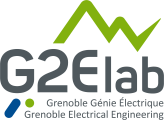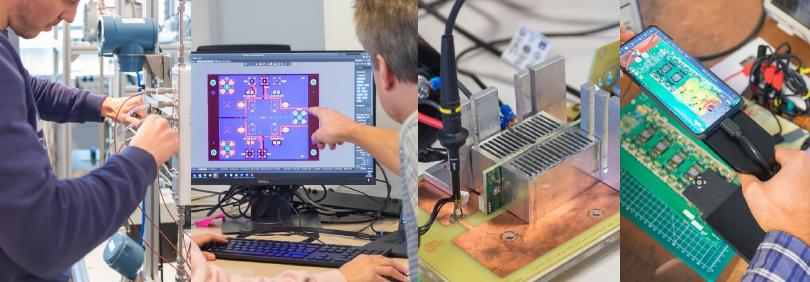The goals of the EP team are to design, model and build energy management and conversion systems that are more and more efficient in terms of compactness, efficiency and environmental compatibility.
To achieve these objectives, the research work is organized around 4 complementary research topics:
- Design
- Integration
- Power electronics in power grids
- Electromagnetic compatibility
The Power Electronics team consists of 10 teachers and researchers and 1 researcher from CNRS, 2 research engineers, and more than 30 PhD students. We also welcome about 10 student interns in the frame of their Master thesis.
Research topics
Design
Synthèse automatique, standard de conception, dimensionnement par optimisation, cycle de vie, caractérisations multiphysiques des convertisseurs.
Intégration
Matériaux et procédés pour l’intégration, modules de puissance, gate drivers, encapsulation, barrière d’isolation, caractérisations électro-thermo-mécaniques, architecture 3D des modules de puissance, développement de solutions technologiques pour briques standardisées, analyse du cycle de vie.
Power electronics in power grids
Convertisseurs multiniveaux, fonctions réseaux spécifiques, commande des structures, Multiple Active Bridge, Cluster de convertisseurs, mise en série de semiconducteurs, gate drivers à haute isolation.
Electromagnetic compatibility
Modélisation CEM des convertisseurs, normes de caractérisation CEM, câblages tridimensionnels hétérogènes, rayonnement des systèmes de conversion d’énergie.
Application fields
- Conversion structures for renewable energy sources
- Power grids (Supergrid, Smartgrid, embedded networks)
- Electric mobility: car, train, plane
- Electromagnetic compatibility in complex systems (embedded networks, buildings)
Experimental and characterization tools
- CARAPACE
- Impedance analyzer
- Thermal impedance and estimate of losses in semiconductors
- Real time simulator
- PHELINE : radiated EMC
Collaborations
Academic collaborations
French universities : AMPERE, Institut NEEL, IMEP, SATIE, LAAS, LAPLACE, LEGI, LEPMI, L2EP
Foreign universities : The University of Nottingham (UK), Gdansk University of Technology (Poland), Sharif University of Technology (Iran), Shiraz University (Iran), The University of Tehran (Iran), CPES Virginia Tech (USA), University of Arkansas (USA), Dartmouth College (USA), Univ of Ain Temouchent (Algérie), Berner Fachhochschule (CH), NTNU Norwegian University of Science and Technology (Norway).
Industry collaborations
Adis, Alstom, CEA-INES, CEA-LETI, CEA-LITEN, Cedrat, CNES, Eaton, Ecoways, Freemens, Hager, Labinal, Liebherr, Luxol, Exxelia Magnetics, Mitsubishi, Schneider-Electric, Siemens, Sirepe, Thalès, Supergrid, Vedecom, Valeo, Safran, Airbus, Zodiac Aerospace, Hager, SNCF, Altair, Adeneo.
Managers
Jean-Christophe Crebier
+33 (0) 4 76 82 63 10
Jean-Luc Schanen
+33 (0) 4 76 82 63 60
Our Team
Key words
Power electronics, static converters, integrated power electronics, control of energy, semiconductors, passive components, cooling, sizing, thermal, EMC, modeling, designing
More details...
Download


